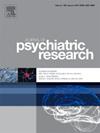精神分裂症的肥胖和自主神经功能障碍:与症状严重程度和发病亚型的关系
IF 3.2
2区 医学
Q1 PSYCHIATRY
引用次数: 0
摘要
精神分裂症(SCZ)与心脏代谢风险升高相关,包括肥胖和自主神经功能障碍。反映自主神经系统(ANS)功能受损的心率变异性(HRV)降低与死亡率增加有关。方法采用正阴性证候量表(PANSS)对70例住院SCZ患者进行评价。HRV通过标准化的5分钟方案测量,评估ANS平衡、迷走神经活动(VAG)和正常到正常间隔的标准偏差(SDNN)。纳入112名年龄匹配健康对照者的HRV数据进行比较。结果与对照组相比,scz患者表现出显著降低的SDNN (17.8 ms对40.5 ms, p < 0.001)。老年肥胖患者的HRV高于年轻的非肥胖患者(SDNN: 27.8 ms vs. 14.3 ms, p = 0.019)。BMI <;24的早发SCZ患者PANSS-N评分(28.3比22.1,p = 0.012)和PANSS-G评分(41.0比35.9,p = 0.049)较高,但HRV无差异。相反,晚发患者,尤其是非肥胖患者,ANS和VAG指数较好(ANS: PCC = 0.643, p = 0.01; VAG, PCC = 0.581, p = 0.023)。男性白细胞计数较高,BMI为24的女性PANSS-N评分较高(p < 0.05)。非肥胖患者使用长效注射抗精神病药物与较高的PANSS-S相关(7.4 vs 4.1, p = 0.036)。结论自主神经功能障碍在SCZ中很明显,特别是在年轻的非肥胖个体中,并且与症状严重程度和发病模式相关。HRV和ANS指标可以作为风险分层和个性化护理的生理指标。本文章由计算机程序翻译,如有差异,请以英文原文为准。
Obesity and autonomic dysfunction in schizophrenia: Associations with symptom severity and onset subtypes
Background
Schizophrenia (SCZ) is associated with elevated cardiometabolic risk, including obesity and autonomic dysfunction. Reduced heart rate variability (HRV), reflecting impaired autonomic nervous system (ANS) function, is linked to increased mortality.
Methods
Seventy inpatients with SCZ were evaluated using the Positive and Negative Syndrome Scale (PANSS). HRV was measured via a standardized 5-min protocol evaluating ANS balance, vagal activity (VAG), and standard deviation of normal-to-normal intervals (SDNN). HRV data from 112 age-matched healthy controls were included for comparison.
Results
SCZ patients exhibited significantly reduced SDNN compared to controls (17.8 ms vs. 40.5 ms, p < 0.001). Older individuals with obesity exhibited higher HRV than younger, non-obese patients (SDNN: 27.8 ms vs. 14.3 ms, p = 0.019). Early-onset SCZ patients with BMI <24 showed higher PANSS-N (28.3 vs. 22.1, p = 0.012) and PANSS-G scores (41.0 vs. 35.9, p = 0.049) without HRV differences. Conversely, late-onset cases, especially among non-obese patients, was associated with better ANS and VAG indices (ANS: PCC = 0.643, p = 0.01; VAG, PCC = 0.581, p = 0.023). Males had higher white blood cell counts, while females with BMI <24 showed higher PANSS-N scores (p < 0.05). Use of long-acting injectable antipsychotics was linked to higher PANSS-S in non-obese patients (7.4 vs. 4.1, p = 0.036).
Conclusion
Autonomic dysfunction is evident in SCZ, particularly in younger, non-obese individuals, and correlates with symptom severity and onset patterns. HRV and ANS metrics may serve as physiomarkers for risk stratification and personalized care.
求助全文
通过发布文献求助,成功后即可免费获取论文全文。
去求助
来源期刊

Journal of psychiatric research
医学-精神病学
CiteScore
7.30
自引率
2.10%
发文量
622
审稿时长
130 days
期刊介绍:
Founded in 1961 to report on the latest work in psychiatry and cognate disciplines, the Journal of Psychiatric Research is dedicated to innovative and timely studies of four important areas of research:
(1) clinical studies of all disciplines relating to psychiatric illness, as well as normal human behaviour, including biochemical, physiological, genetic, environmental, social, psychological and epidemiological factors;
(2) basic studies pertaining to psychiatry in such fields as neuropsychopharmacology, neuroendocrinology, electrophysiology, genetics, experimental psychology and epidemiology;
(3) the growing application of clinical laboratory techniques in psychiatry, including imagery and spectroscopy of the brain, molecular biology and computer sciences;
 求助内容:
求助内容: 应助结果提醒方式:
应助结果提醒方式:


